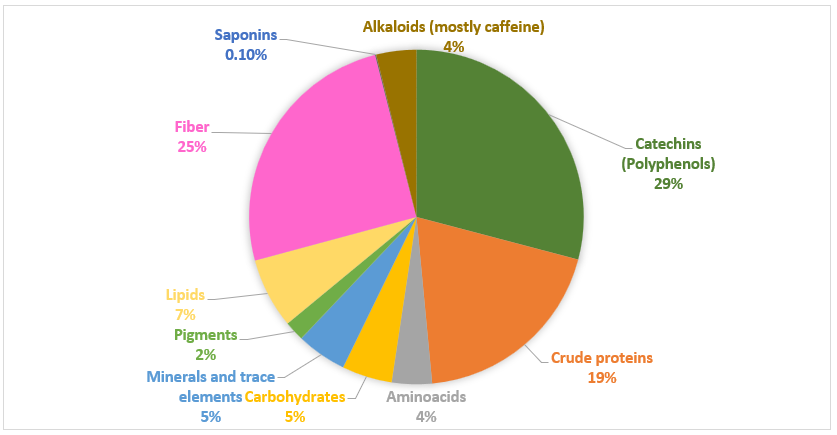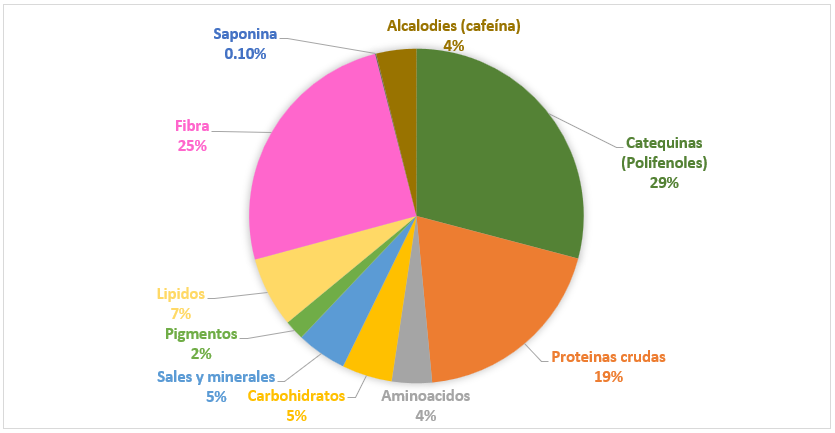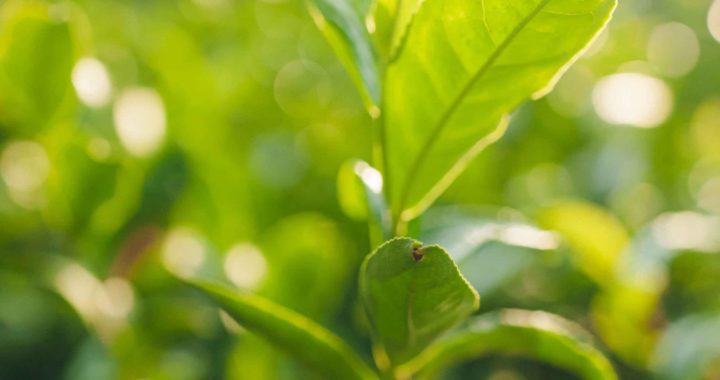Para el texto en español [PULSA AQUI]
Hello everyone! My name is Lourdes, one of the new interns in this amazing adventure that is life at Obubu! よろしくお願いします!
If you are reading this article is because you love tea, right? I associate tea with a moment of stillness and calm. Tea can be brewed in any situation: maybe when you return after a long day from work, maybe when you are catching up with friends or maybe you make that cup of tea for that person that is having a rough day. The emotional and social aspects of tea are fascinating to me, and I also wonder how does Japanese green tea affect our physical health? Is there a connection between the two? Why do green tea components affect our body like that? In this three-part article, I will write about the physical and psychosocial aspects of tea.
But first… buckle up because this is going to get scientific and NERDY!
Hello, I am Tea-chan! You will see more of me in the next issue!
JAPANESE GREEN TEA COMPOSITION
To start understanding tea, we must understand the components found in tea. The biochemical composition of green tea will change depending on the cultivar, geography, stages of growth, agricultural practices, climatic conditions, and age of the leaf.
BIOCHEMICAL COMPONENTS OF GREEN TEA (DRY LEAVES)
 Combined data compiled from Chacko SM et al.3, Tang et al.6 and ITO EN4
Combined data compiled from Chacko SM et al.3, Tang et al.6 and ITO EN4
Most green tea polyphenols are flavonols and within that category we have catechins. These water-soluble polyphenols shine for their antioxidant qualities and contribute to the astringency and bitterness of green tea1. The steaming process right after harvest helps maintain high catechin contents in the leaf. Green tea contains four main catechins, i.e., (−)-epicatechin (EC), (−)-epicatechin-3-gallate (ECG), (−)-epigallocatechin (EGC) and (−)-epigallocatechin-3-gallate (EGCG)2. The latter is the most abundant and there are tons of research that talk about their health benefits.
L-THEANINE
L-Theanine is an amino acid found in the Camellia Sinensis plant and is a natural analog to glutamate, another amino acid that serves as a precursor to the neurotransmitter GABA. The binding of L-Theanine to the glutamate receptors starts a chain of chemical reactions that might selectively increase the levels of serotonin and dopamine, both “feel good” neurotransmitters5. L-Theanine can also improve our cognitive function by facilitating the hippocampus’s synaptic efficiency6. In other words, our hippocampus deals with learning, emotions, and memory formation and L-Theanine stimulate that. A cool amino acid, right? 
Shaded teas produce more L-theanine than those grown fully in the sun.
CAFFEINE
Any coffee addicts here? Have you ever heard someone say, “I need my caffeine fix”? Then you must know about the properties of caffeine! Caffeine is one of the most consumed psychoactives in the world. This component is a methylxanthine, a type of alkaloid, that stimulates the central nervous system (CNS) and can increase our mental alertness and thought processing8. On the other hand, beware of the effect of high amounts of caffeine as it could cause you increased heart rate and anxiety! A cup of green tea contains on average 16.28 mg/g of caffeine5 and a safe dosage to consume appears to be up to 400mg of caffeine per day (200mg in pregnancy).
Tea fanatics are lucky as the L-Theanine components in tea keep the excitative effects of caffeine in check5.
VITAMINS, MINERALS AND TRACE ELEMENTS
After harvesting, leaves are steamed at a high temperature after harvesting to inactivate the polyphenol oxidizing enzymes, which protect many vitamins and minerals present in the tea11. Depending on the ingestion method (brewed vs eaten) you will get higher or lower amounts of these components as some of them are not water-soluble. Green tea contains Vitamin A, B1, B2, B6, B12, C, and D as well as potassium (K), calcium (Ca), phosphorus (P), and magnesium (Mg), as well as small quantities of manganese (Mn), zinc (Zn) and copper (Cu)9,10.
CARBOHYDRATES AND LIPIDS
Green tea contains carbohydrates such as cellulose, pectins, glucose, fructose, and sucrose as well as small lipid amounts of linoleic and α – linolenic acids10.
PIGMENTS
Due to the steaming process that destroys the enzymes responsible for breaking down pigments such as chlorophyll, Japanese tea can keep its known green colour during the rolling and drying processes.
SAPONINS
Saponins are present in all teas and can thank their name for their soap-like properties. This component is the reason why frothing can be seen in matcha4.
And that is all for now! So much to say about a little leaf, right?
In the next issue, I will talk about the effects of Japanese green tea on our bodies.
The text references are at the end of the post.
[SPANISH VERSION]
¡Hola! Me llamo Lourdes y soy una de las nuevas becarias en esta fantástica aventura en la granja de Obubu.よろしくお願いします!
Si estás leyendo esto es porque amas el té, ¿verdad? Asocio el té con momentos de quietud y calma. Un té puede prepararse en cualquier situación: después de un día duro en el trabajo, cuando te estás poniendo al día con amigos o cuando alguien está teniendo un mal día. Los aspectos emocionales y sociales de el té son fascinantes y también me pregunto… ¿cómo afecta a nuestra salud física el té verde japonés? ¿Hay una conexión entre los dos? ¿Por qué nos afectan los componentes del té verde? En este artículo de tres partes voy a escribir sobre los efectos físicos y psicosociales del té.
Pero primero… ¡ponte el cinturón porque esto se va a poner científico y FRIKI!
 ¡Hola, soy Té-chan! ¡Me verás más en el próximo artículo!
¡Hola, soy Té-chan! ¡Me verás más en el próximo artículo!
LOS COMPONENTES DEL TÉ VERDE JAPONÉS
Para empezar a entender el té debemos entender los componentes presentes en él. La composición bioquímica del té verde cambia dependiendo del varietal, geografía, estados de crecimiento, prácticas agrícolas, clima y edad de la hoja.
COMPONENTES BIOQUÍMICOS DE EL TÉ VERDE (HOJA SECA)
 Combinación de datos encontrados en Chacko SM et al.3, Tang et al.6 e ITO EN4
Combinación de datos encontrados en Chacko SM et al.3, Tang et al.6 e ITO EN4
La mayoría de los polifenoles del té verde son flavonoles. Dentro de esa categoría encontramos las catequinas. Estos polifenoles hidrosolubles brillan por sus cualidades antioxidantes y contribuyen a la astringencia del té verde1. El proceso de fijación por escaldado justo después de la cosecha ayuda a mantener altos contenidos de catequinas en la hoja. El té verde contiene cuatro catequinas principales: (−)-epicatequina (EC), (−)-epicatequina-3-galato (ECG), (−)-epigalocatequina (EGC) and (−)-epigalocatequina -3-galato (EGCG)2. La última es la más abundante y hay cientos de artículos científicos que hablan de sus beneficios para la salud.
L-TEANINA
L-Teanina es un amino acido encontrado en la planta de Camelia Sinensis y es un análogo natural del glutamato, otro amino nacido que sirve como precursor al neurotransmisor GABA. La unión de la L-Teanina a los receptores glutámicos comienzan una reacción en cadena que podrían incrementar selectivamente los niveles de serotonina y dopamina, ambos neurotransmisores con efectos positivos para la mente5. La L-Teanina también mejora nuestra función cognitiva debido a que facilita la eficiencia sináptica del hipocampo6. En otras palabras, nuestro hipocampo se encarga del aprendizaje, estados emocionales y gestión de la memoria y la L-Teanina estimula esas funciones. Un amino acido guay, ¿no?
Tés que crecen en la sombra producen más L-Teanina que los que crecen bajo el sol.
CAFEÍNA
¿Algún adicto al café presente? ¿Has oído a alguien decir: “necesito mi dosis de cafeína”? ¡Entonces seguro que conoces las propiedades de la cafeína! La cafeína es uno de los psicoactivos más consumidos en el mundo. Este componente es una metilxantina, un tipo de alcaloide, que estimula el sistema nervioso central (SNC) y puede incrementar nuestra agilidad mental y razonamiento8. Por otra parte, ¡cuidado con los efectos causados por los niveles elevados de cafeína ya que puede aumentar tu ritmo cardiaco y causarte ansiedad! Una taza de té verde contiene de media 16.28 mg/g de cafeína5 y la dosis recomendada al día parece ser de unos 400mg (200mg durante el embarazo).
Los fanáticos de el té están de suerte ya que la L-Teanina mantiene a raya los efectos excitativos de la cafeína5.
Después de la cosecha, las hojas son pasadas al vapor a altas temperaturas para inactivar las enzimas polifenol oxidasa y eso protege muchas de las vitaminas y minerales presentes en el té11. Dependiendo del método de ingesta (bebido vs comido) podrás consumir más o menos cantidades de estos componentes ya que algunos no son hidrosolubles. El té verde contiene Vitamina A, B1, B2, B6, B12, C and D a la vez que potasio (K), calcio (Ca), fosforo (P), and magnesio (Mg), poequeñas cantidades de manganeso (Mn), zinc (Zn) y cobre (Cu)9,10.
CARBOHIDRATOS Y LÍPIDOS
El té verde contiene carbohidratos como celulosa, pectinas, glucosa, fructosa y sucres a la vez que pequeñas cantidades de lípidos como el ácido linoleico y ácidos α – linolénico 10.
PIGMENTOS
Debido al proceso de vapor que destruye las enzimas responsables de descomponer pigmentos como la clorofila, el té verde japonés puede mantener su color verde durante los procesos de enrulado y secado.
SAPONINAS
Las saponinas se pueden encontrar en todos los tés y reciben su nombre por sus propiedades similares al jabón. Este componente es la razón por la que el matcha contiene espuma4.
¡Y eso es todo por ahora! Tanto que decir por una hoja tan pequeña, ¿verdad?
En el próximo artículo trataré de los efectos de el té verde japonés en nuestro cuerpo.
REFERENCES/REFERENCIAS
- Musial, C., Kuban-Jankowska, A., & Gorska-Ponikowska, M. (2020). Beneficial Properties of Green Tea Catechins. International Journal of Molecular Sciences, 21(5), 1744. https://doi.org/10.3390/ijms21051744
- Kochman, J., Jakubczyk, K., Antoniewicz, J., Mruk, H., & Janda, K. (2020). Health Benefits and Chemical Composition of Matcha Green Tea: A Review. Molecules, 26(1), 85. https://doi.org/10.3390/molecules26010085
- Chacko, S. M., Thambi, P. T., Kuttan, R., & Nishigaki, I. (2010). Beneficial effects of green tea: a literature review. Chinese medicine, 5, 13. https://doi.org/10.1186/1749-8546-5-13
- Major components and health benefits of Green Tea. ITOEN ©ITO EN, All Rights Reserved. (n.d.). Retrieved June 2, 2022, from https://www.itoen-global.com/allabout_greentea/components_benefit.html
- Wang, L., Brennan, M., Li, S., Zhao, H., Lange, K. W., & Brennan, C. (2022). How does the tea L-theanine buffer stress and anxiety. Food Science and Human Wellness, 11(3), 467–475. https://doi.org/10.1016/j.fshw.2021.12.004
- Tang, G. Y., Meng, X., Gan, R. Y., Zhao, C. N., Liu, Q., Feng, Y. B., Li, S., Wei, X. L., Atanasov, A. G., Corke, H., & Li, H. B. (2019). Health Functions and Related Molecular Mechanisms of Tea Components: An Update Review. International journal of molecular sciences, 20(24), 6196. https://doi.org/10.3390/ijms20246196
- Higashiyama, A., Htay, H. H., Ozeki, M., Juneja, L. R., & Kapoor, M. P. (2011). Effects of l-theanine on attention and reaction time response. Journal of Functional Foods, 3(3), 171–178. https://doi.org/10.1016/j.jff.2011.03.009
- Caffeine: Benefits, Risks and Effects-A Review. (2020). Indian Journal of Public Health Research & Development. https://doi.org/10.37506/ijphrd.v11i3.1161
- Bisogno, V., & Pettigrew, J. (2021). Manual del Sommelier de Té: Variedades, cata y protocolo del Té (Spanish Edition). El Club del Té Libros.
- Ratnani, S., & Malik, S. (2022). Therapeutic Properties of Green Tea: A Review. Journal of Multidisciplinary Applied Natural Science, 2(2), 90-102. https://doi.org/10.47352/jmans.2774-3047.117
- Prasanth, M., Sivamaruthi, B., Chaiyasut, C., & Tencomnao, T. (2019). A Review of the Role of Green Tea (Camellia sinensis) in Antiphotoaging, Stress Resistance, Neuroprotection, and Autophagy. Nutrients, 11(2), 474. https://doi.org/10.3390/nu11020474




